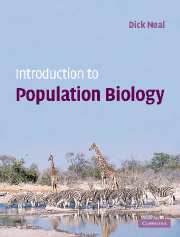Book contents
- Frontmatter
- Contents
- Preface
- Acknowledgements
- PART I Evolution by natural selection
- PART II Simple population growth models and their simulation
- PART III Population genetics and evolution
- PART IV Demography
- PART V Interactions between species, and the behaviour of individuals
- Glossary
- Solutions to problems
- References
- Index
PART II - Simple population growth models and their simulation
- Frontmatter
- Contents
- Preface
- Acknowledgements
- PART I Evolution by natural selection
- PART II Simple population growth models and their simulation
- PART III Population genetics and evolution
- PART IV Demography
- PART V Interactions between species, and the behaviour of individuals
- Glossary
- Solutions to problems
- References
- Index
Summary
This part of the book provides an introduction to some simple mathematical models that describe the growth of populations, and Quattro Pro and Excel spreadsheet programs are used to simulate these populations. The emphasis is on making a quantitative assessment of the consequences of Darwin's ‘overproduction of offspring’ and some aspects of ‘the struggle for existence’.
Two basic types of population growth models are described. First, the consequences of Darwin's ‘overproduction’ of organisms are considered in Chapter 4, and described in mathematical terms using the geometric and exponential growth models. These models assume that there are no limits to the numbers of organisms and show that all populations growing in this manner will soon exhaust the earth's resources. Second, in Chapter 5 we look at one aspect of Darwin's ‘struggle for existence’, intraspecific competition, which occurs when a population grows in an environment of finite size. This form of growth is described using the logistic, or sigmoid, growth model, which has some rather restrictive assumptions. This basic model is then modified to assess the effects of time lags and environmental variation on the form of population growth. The models are applied to laboratory and field data show how they relate to reality.
- Type
- Chapter
- Information
- Introduction to Population Biology , pp. 51 - 52Publisher: Cambridge University PressPrint publication year: 2003



